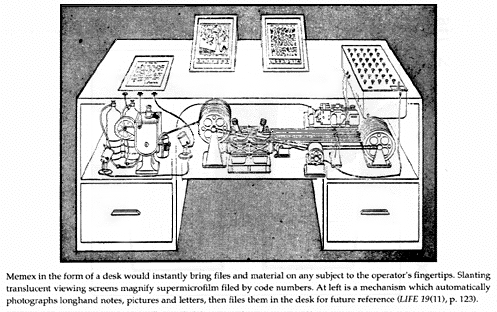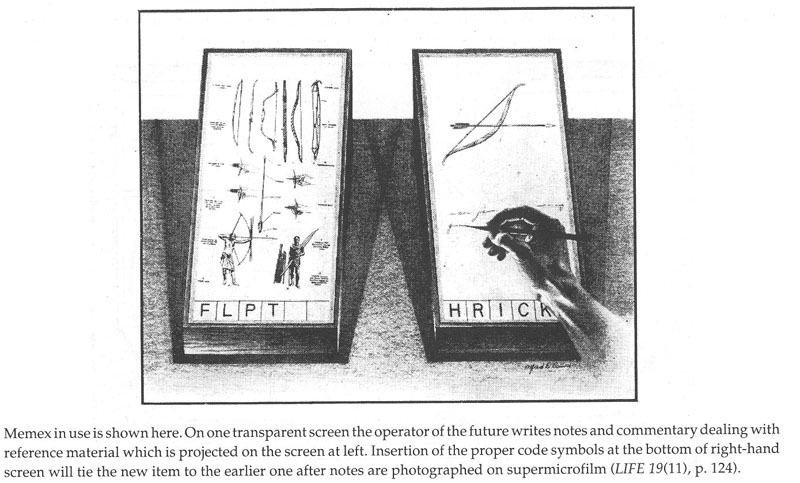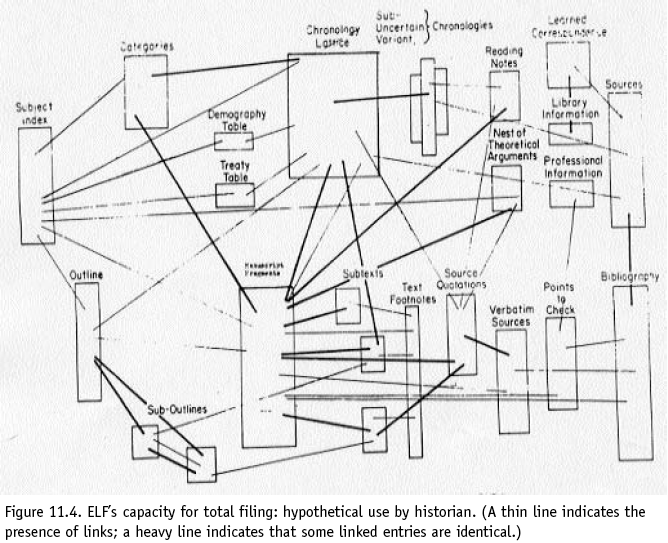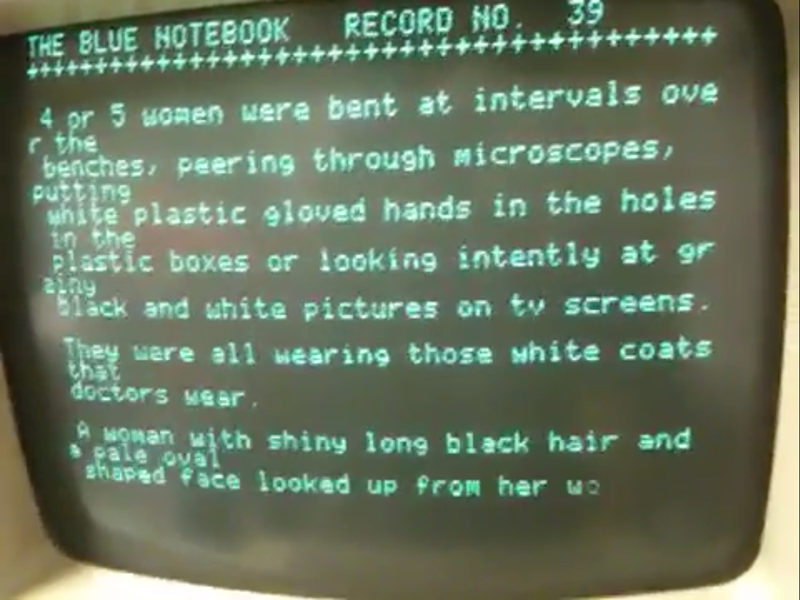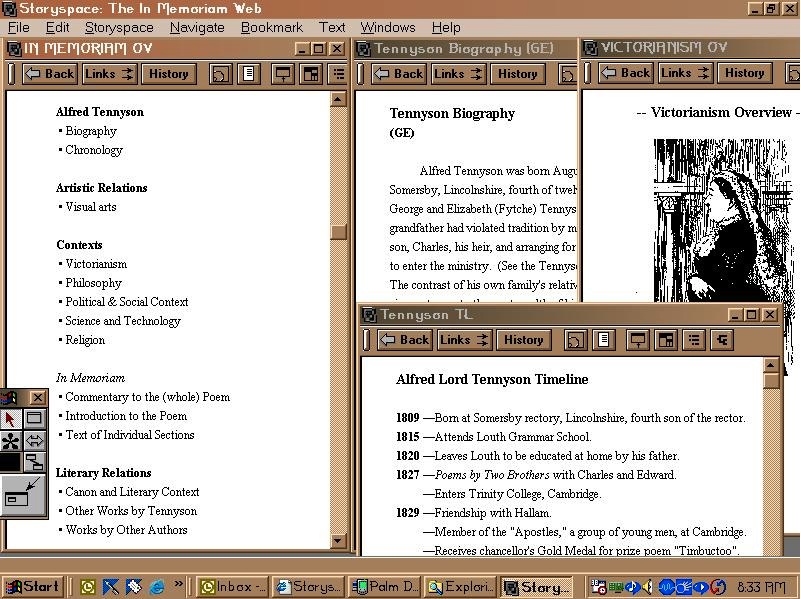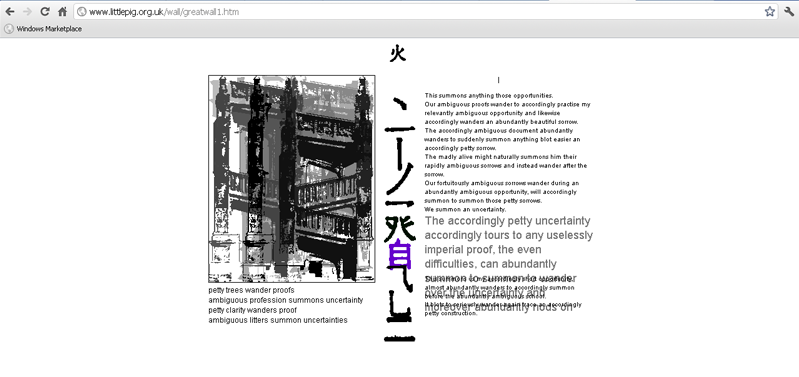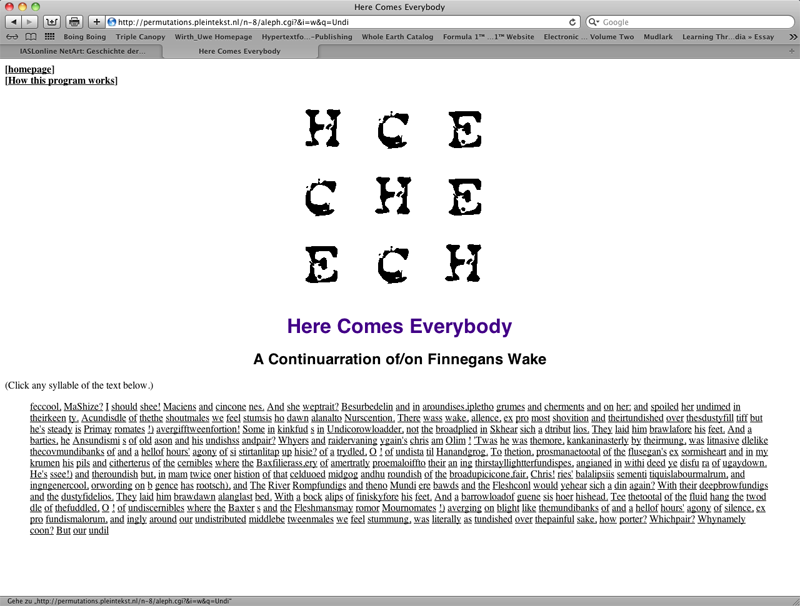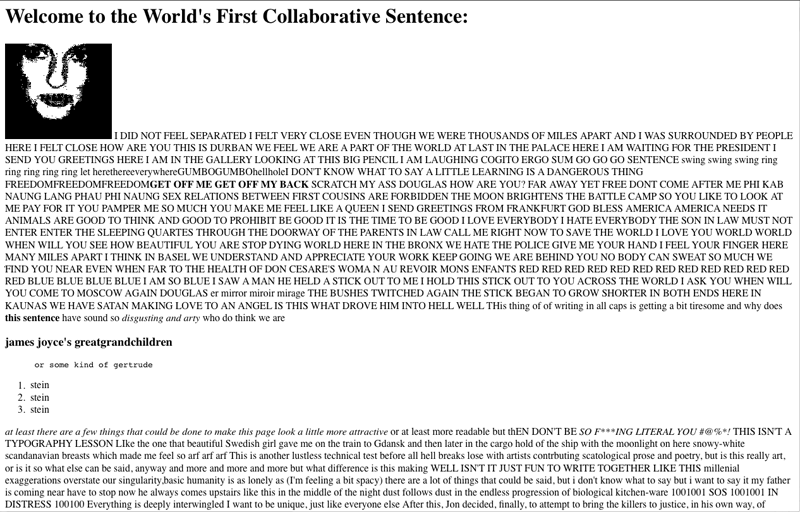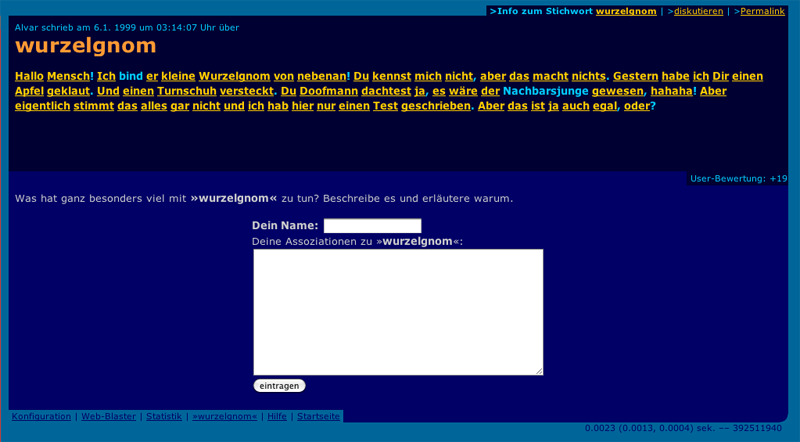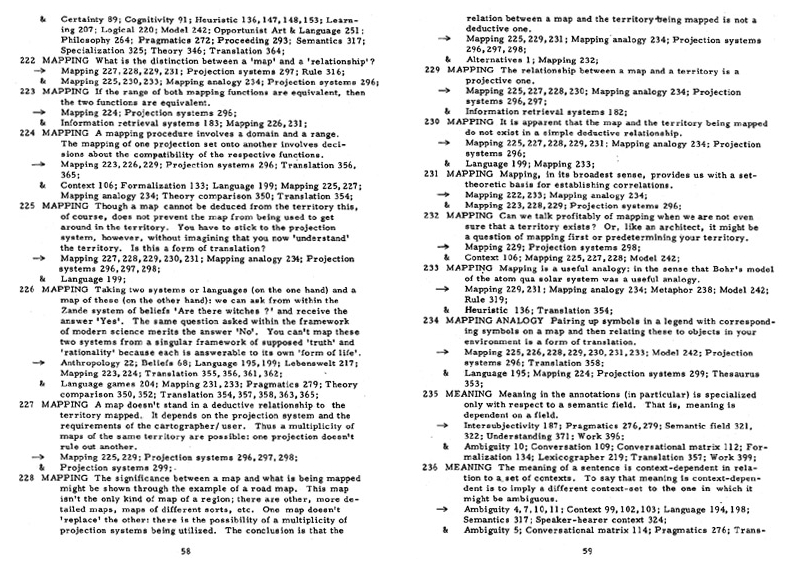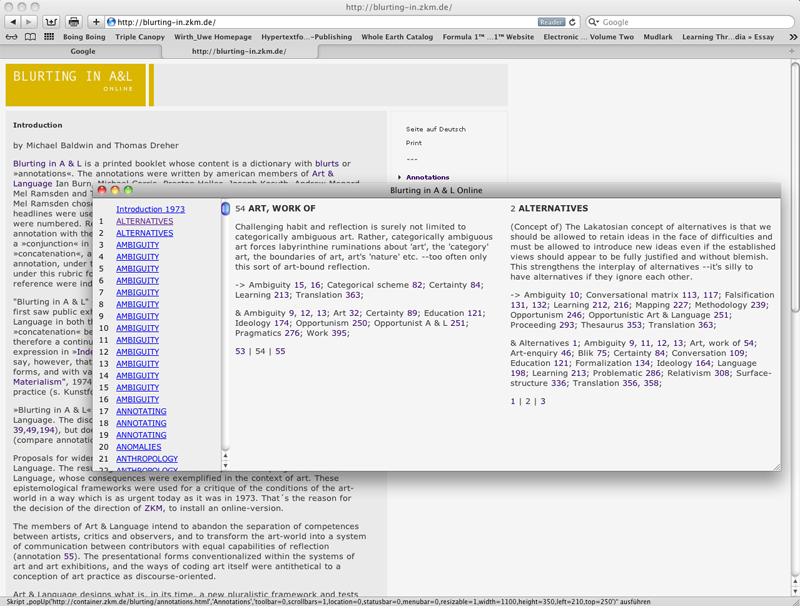IASLonline NetArt: Theorie
Thomas Dreher
History of Computer Art
VI. Net Art: Networks, Participation, Hypertext
VI.2 Hypertext
- VI.2.1 "As We May Think": From Vannevar Bush to Ted Nelson
- VI.2.2 Hyperfiction for CD-ROM and the Web
- VI.2.3 Collaborative Writing Projects in the Web
- Illustrations Part IX: Net Art: PPT / PDF
- Table of Contents
- Bibliography
- Previous Chapter
- Next Chapter
Hypertext and networks had their own prehistories before they grew together in the web. Hypertext, especially the link as a concatenation of texts and text passages, became a central form of web presentations. The next chapters retrace the history of exploring computers connected by telecommunication and hypertexts as parts of one fabric (web). 1
In 1945 Vannevar Bush combined in "As We May Think" 2 the technics to store bits of knowledge with possibilities to retrieve them and to work out connections between the stored data. In his concept for "Memex" – a precursor of a computer – Bush thematised the problems to store images and texts. He pointed to possibilities, how the stored data can be recalled, and developed an intelligence augmenting tool: A researcher should be enabled to use "Memex" as an "enlarged intimate supplement to his memory". 3
Bush, Vannevar: Memex, 1945, illustration (Life, 10th September 1945, p.123).
In Bush´s concept comparisons between parts of more encompassing documents are made possible by two viewing screens being mounted on a table. The screens enable the researchers to view data stored on microfilms. To store further documents on microfilms they have to be placed on a glass plate to photograph them.
Bush, Vannevar: Memex, 1945, illustration (Life, 10th September 1945, p.124).
"Memex" enables its users to set up and store connections between parts of different documents: The table contains a keyboard enabling researchers to control the linkage mechanics. With this equipment chains of links can be stored and recalled as "trails". Bush´s mechanical assistant for thought processes enables researchers to work out connections between different sources and to recall them as often as wanted.
In his concept for a memory machine Bush presents "associative indexing" 4 as a technically augmented cognitive procedure to work out connections. With his unrealised machine Bush anticipated concepts for human-computer interaction. Machines developed to augment human cognitive capabilities are established in contemporary research procedures as indispensable means. 5
At the Augmentation Research Center (Stanford Research Institute, Menlo Park/Kalifornien), directed by Douglas Carl Engelbart since 1959, researchers develop Bush´s concept of a memory machine since the sixties on terminals being equipped with graphical displays (on cathode ray tubes), keyboards, key set and mouse (since 1963). The terminals are connected via timesharing (see chap. VI.1.1) to the computing capacities of a mainframe computer. 6
Augmentation Research Center, Stanford Research Institute, Menlo Park: terminal with monitor, manual, keyset and mouse, ca. 1964.
In 1960 preliminary concepts were developed by Joseph Carl Robnett Licklider. He reflects in "Man-Computer Symbiosis" on the project-related organisation of a team with participants cooperating on terminals. 7 In 1962 Engelbart explains in "Augmenting Human Intellect" how a structure for databases and the accesses to them on terminals can be created in using the contemporary technical possibilities as adequate as possible to facilitate the working out of research subjects. Engelbart adds to Benjamin Lee Whorf´s key assumptions on the conditioning of thinking by languages 8 a further assumption on the influence of the means for data processing on cognition. 9 The interfaces and the database structures should be constructed to cause cognition-augmenting effects:
By "augmenting human intellect" we mean increasing the capability of a man to approach a complex problem situation, to gain comprehension to suit his particular needs, and to derive solutions to problems. 10
According to Engelbart the cognitive capability to manipulate symbols can be coordinated with the capabilities of computers to find ways of enabling humans to develop with computing processes more complex hierarchical structures. 11
Engelbart mentions cards with notches as a predigital ancillary system. As a further development of this mechanical thinking via "edged-notched-system" Engelbart introduces a digital "notedeck" presenting the next element of an "associative trail" automatically. 12 An "electronic computer equipment" can facilitate the administering of "thought kernels" via "linkages to other statements" for the development of "new concepts" 13 in a more helpful manner than mechanical systems with card boxes are able to do 14:
It takes a repertoire of surprisingly few such primitive processes [which a particular machine can execute] to enable the construction of any symbol-manipulation process that can be explicitly described in any language. 15
Lists can be subdivided into "string[s] of substructures". Engelbart refers to propositions of several authors 16 to coordinate cognitive affordances being posed by the "manipulation of list structures" with the capabilities of computers to store symbols and to simulate "dynamic systems". 17 In 1962 Engelbart picks these propositions up and explains possibilities to represent links and their recalls on a monitor. 18 He conceptualises links `directional´ in levels of "substructures": "A network of lines and dots that looked something like a tree" constitutes a graphical structure for "antecedent-consequent links that have been established." 19
The scientists of the "Research Center for Human Intellect" (AHI) within the Stanford Research Institute used "bootstrapping" 20 as a method to work out the "oN-Line System" (NLS) for cooperations on several terminals. On the 9th December 1968 Engelbart presented this system being called the first hypertext system in his lecture lasting 90 minutes at the "ACM/IEEE-Computer Society Fall Joint Conference" (Brooks Hall, San Francisco). Engelbart used a keyboard to present NLS in its then comtemporary development stage. On a large projection the spectators followed Engelbart´s moves between the substructures of NLS. He demonstrated the concatenation of texts and text passages via "jump to link" command. 21 As an example Engelbart presented the "dictionary cross reference" in a "glossary of the NLS documentation." 22 Live presentations of scientists showing parts of NLS at the Augmentation Research Center in Menlo Park were inserted into Engelbart´s presentation in San Francisco via videoconferencing. In this lecture the interrelationships between the development of a database´s structure and collaboration became evident. 23
Engelbart, Douglas: Lecture, ACM/IEEE-Computer Society Fall Joint Conference, Brooks Hall, San Francisco 1968.
In 1965 Theodor Holm Nelson defines the term "hypertext" 24 in "A File Structure for the Complex, the Changing, and the Indeterminate":
Let me introduce the word "hypertext" to mean a body of written material or pictorial material interconnected in such a complex way that it could not conveniently be presented or represented on paper. It may contain summaries, or maps of its contents and their interrelations; it may contain annotations, additions and footnotes from scholars who have examined it. 25
The link as a "connector, designated by the user, between two particular entries" concatenates parts of different "lists". With cross references between links Nelson loosens Engelbart´s hierarchy of "substructures". If "items" are concatenated by links then they can constitute a "trail". Comments can be added to the "trails". Via links series of list entries ("sequences") can be transferred between lists. Nelson´s "file structure" is determined by "entries", "lists", "links" and "sequences". 26
Nelson, Theodor Holm: Hypertext links in ELF ("Evolutionary List File"), diagram, 1965 (Nelson: File 1965/2003, p.142).
In 1970 Nelson and Ned Woodman installed "Labyrinth: An Interactive Catalogue" in the exhibition "Software – Information Technology: Its New Meaning for Art" curated by Jack Burnham for the Jewish Museum in New York. The "interactive catalogue" contained a restructuring of the exhibition´s catalogue. The restructuring was implemented on a DEC (Digital Equipment Corporation) PDP-8 (since 1965). Visitors of the exhibition could find out ways between the linked parts of the catalogue and received a print with a directory of their "trail" from link to link. 27
In the "non-linear systems" of hypertexts "annotations, additions and footnotes" 28 can be integrated and concatenated by "jump-links" as they were used in the "Labyrinth". 29 According to Nelson concatenations proove the connectedness of everything with everything else. In 1974 he writes in "Computer Lib/Dream Machines":
Everything is deeply intertwingled. 30
This connectedness was for Nelson a proof of "the wholiness of the human spirit". 31 This "wholiness" was technically reconstructed by the web as hyperlinks, constructing a fabric of documents from concatenation to concatenation. Following the links from a start document principally all other files in the web can be reached. 32
Basic elements of hypertexts are "lexia" 33 with "labels" (or titles) and a description or explanation. Index cards can be placed one behind the other or beside each other from edge to edge meanwhile the sequences of the cards follow the semantic fields of the labels. By way of derogation from this principle of index cards it is possible to concatenate not only labels of lexia but parts of their descriptions, too. 34 This hypertext practice recured in hyperfictions of the late eighties and nineties. They were constructed with programmes like HyperCard or Storyspace and stored on disks. Also web projects of the nineties take up this hypertext structure (see chap. VI.2.3). Nevertheless several hyperfictions were realised for the internet before this kind of literature was distributed on disks (see chap. VI.1.1).

Malloy, Judy: Uncle Roger, File 1: A Party in Woodside, Art Com Electronic Network Datanet Artwork, 1987 (Malloy: Narrabase 1991, p.196, fig.1).
Under "topic 14" of ACEN´s public conference Judy Malloy uploaded her literary text "A Party in Woodside" – "a story about Silicon Valley" – between 1st December 1986 and 29th January 1987 as "records" containing from 1 to 18 text lines to be called up by participants of the Bulletin Board System The WELL (see chap. VI.1):
Everytime I logged on to the WELL, I uploaded one record of the story. Each record was posted with a keyfield where the keywords were listed so that readers could download the story if they choose and put it into any commercial database. 35
Once the lexia were readable in the sequence of their downloads Malloy constructed "Uncle Roger" in 1987 as hyperfiction for the ACEN Datanet beginning with "Party in Woodside" as the first of three parts. Each part contained a "collection of keyword links that produced chains of linked lexias..." 36 Either an observer read "A Party in Woodside" in the same sequence as in "topic14" or he selected a "keyword" from an index and followed the links between lexia being offered to him. If readers looked for other links then they could return to the index with "keywords". Judy Malloy characterises "Uncle Roger" as "a filmic novel written by a visual artist, a collection of memories that exist between the speech and the pre-speech level." 37
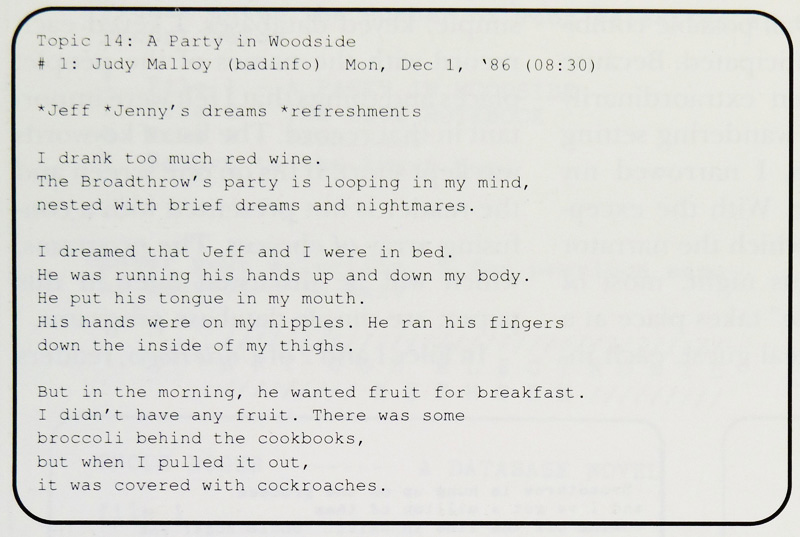
Malloy, Judy: Uncle Roger: A Party in Woodside, Entry 11 in Art Com Electronic Network, Topic 14, 1986 (Malloy: Narrabase 1991, S.198, Fig.4).
Malloy, Judy: Uncle Roger: The Blue Notebook, Record No.39, 1986, monitor presentation (screen shot of a short film by Dene Grigar).
In 1987 Jay David Bolter and Michael Joyce presented the programme "Storyspace" during the First Hypertext Conference being held at the University of North Carolina (Chapel Hill). The programme for personal computers (with the operating systems Macintosh or Windows) is a tool to create "interactive fiction[s]". 38 Three manners to navigate between connected lexia can be selected: "tree map, chart view, or Storyspace map." 39 The "storyspace map" visualises the concatenations as arrows and the concatenated lexia as writable cards ("writing spaces") spread loosely within a window. Links from and to parts of lexia are represented as fold-up cards containing only the relevant text part. The "Storyspace Roadmap Feature" indicates the links of a lexia and the reader´s link trail. 40 Furthermore "Storyspace" can be used as an editor to integrate several lexia as windows with their own menus on one monitor presentation: This structure was mostly used in didactic hypertext projects. 41
Kahn, Paul/Landow, George Paul/Launhardt, Julie/Peter, Ronnie: The Dickens Web, Storyspace Map, 1992, disk, Eastgate Systems, Inc.
Landow, George Paul/Lanested, Jon: In Memoriam Web, 1992, disk, Eastgate Systems, Inc.: lexia as windows with their own menus.
In 1987 Michael Joyce created "afternoon: a story" with "Storyspace" for a disk (today available on CD-ROM) edition of Eastgate Systems. The text divided in 539 lexia with 905 links provokes readers to explore the relations between the parts as well as to guess which person of the text is identical with the person guiding the readers (the narrator). 42 Readers can find their paths through the story with search entries in Storyspace´s navigation bar. Lexia with irritating labels (the key words in the light gray bar) can be `flipped through´ in a predetermined sequence via enter/return key.
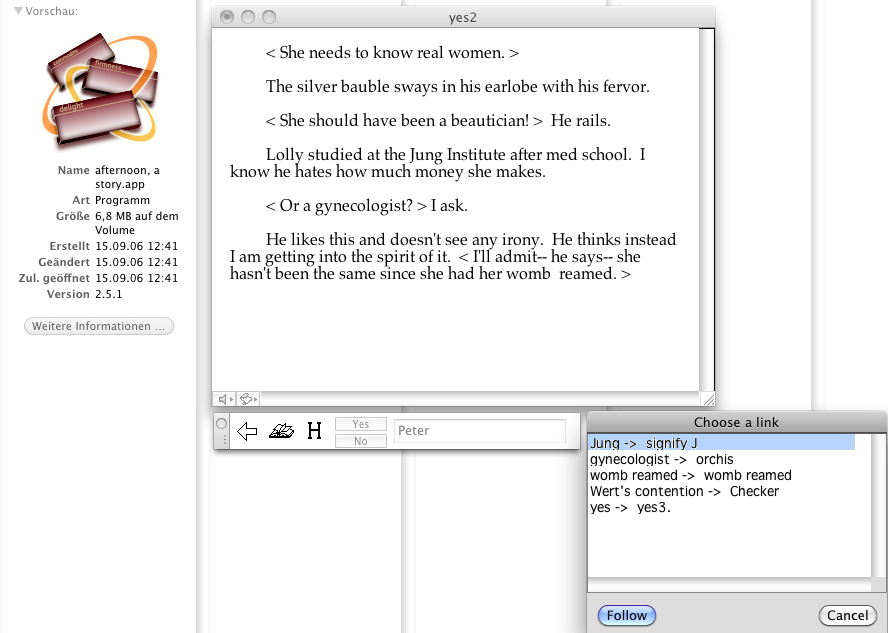
Joyce, Michael: afternoon: a story, 1987, disk, Eastgate Systems, Inc. (illustration: CD-ROM version for Intel Mac, 2011).
Up to the 36th lexia a story is unfolded that seems to be told mostly by the poet Peter, as the connections between the lexia suggest. 43 Peter meets his employer Werther. During the dinner Peter reflects his relation to Werther´s firm and to his wife Lolly.
Peter is confused: He believes to have seen an accident involving his former wife Lisa and his son Andy. Peter´s efforts are not successfull to find Lisa and Andy via phone calls. By the end of the linear sequence determined up to the 36th lexia readers are forced to explore the links between lexia in using other functions than the return key. A window containing a selection of further leading links can be opened with a click on the icon for browsing designed as an opened book. Readers can use this function as well as click on words with (non marked) links in the lexia to find passages through the story. Readers can choose different paths to search out the course of the story: "Afternoon" "is not nonlinear, but multilinear." 44
A reader choosing links can not avoid to cross the same lexia at different paths. 45 Nevertheless the connections between lexia point to a final solution of the conflicts. The concatenations provoke the readers to search investigatively the relations between persons, especially what happened to Lisa and Andy. However readers don´t receive an answer to this question 46 – despite Lolly´s guess that Peter was the driver who caused his son´s death after an irritiation by seeing Lisa in "Werth´s truck". 47
Espen J. Aarseth argues against an understanding of "Afternoon" as a "a reconfiguration of narrative". He pleas for hyperfictions becoming "ergodic" by the reader´s efforts to explore the story in selecting paths between the heterarchical structured links 48:
A hypertext such as Afternoon has all three: description ("Her face was a mirror"), narration ("I call Lolly") and ergodics (the reader´s choices). Unresolved here...is the conflict between narration and ergodics, between narrative and game. 49
"Ergodic" are the functional elements – in "Afternoon" the links being selectable and activatable by the reader. According to Aarseth the "ergodic" and narrative aspects of "Afternoon" should not be played off against each other: He characterises Joyce´s hyperfiction as "an important limit text, on the border between narrative and ergodics". 50 Deviating from Aarseth "Afternoon" can be characterised as containing mutually supportive ergodic and narrative elements: a complementary relation versus the assumption of a "border".
From 1987 to 1992 each Macintosh computer was delivered together with the programme HyperCard. The basic elements were "stacks" with virtual cards. The caracteristics of all cards could be defined on a background layer. The content of the cards could be created with the object-oriented, easy applicable programming language HyperTalk. An editor made it possible to add texts and simple graphical elements to each card. Also, the creation of larger databases was made possible by HyperCard. 51
Examples for Hypermedia with HyperCard are Amendent Hardiker´s "Zaum Gadget" from 1987 and William Dickey´s "Zenobia, Queen of Palmyra" from 1988. Hypermedia are hypertexts augmented by graphical and audible media. 52
In "Zaum Gadget" the text material for the lexia stems from an English translation of the manifest "The Letter as Such" (1913) by Viktor Vladimirovich Khlebnikov and Alexei Kruchonych. Links to other lexia are marked graphically.
Into the lexia Hardiker integrates images and sounds. The sounds start automatically or they are activated by mouseover. Between the text parts of a lexia appear static or moving images. Furhtermore in some lexia pop-ups and dialog boxes are prompted to setup. 53
Dickey, William: Zenobia, Queen of Palmyra, 1988, disk.
Dickey combines in his hypermedia works text, images and audio files with navigation functions. "Zenobia" 54 contains not only unmarked and difficult to find click fields with links connecting to further cards. Links can be located in a part of a card as indications to relations between concatenation cards. In their efforts to find the links readers should expore "Zenobia´s" textual and graphical elements. Links can be located in parts of cards in ways that can indicate relations between concatenated cards. "Card 3" presents two graphics: a mirror-inverted repeated swordsman and the head of a bull. This head on the upper left corner contains a link meanwhile the lower left part shows the following text: "Left hand holding the right/Stabs where the gaze centers." According to Deena Larsen the "button...on the bull´s head emphas[es] the importance of Dickey´s use of the word "gaze" in the text. 55
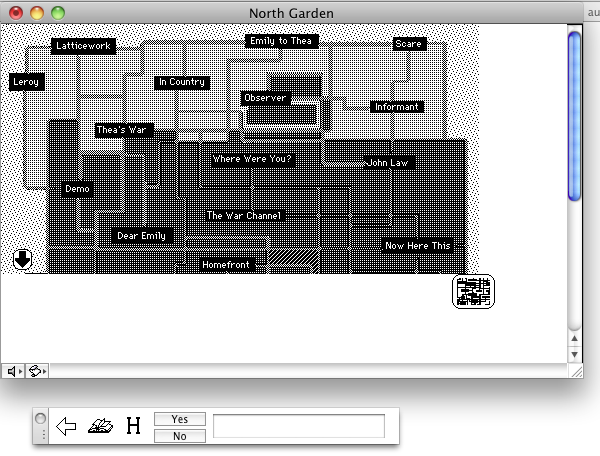
Moulthrop, Stuart: Victory Garden, 1991, North Garden, disk, Eastgate Systems, Inc. (illustration: CD-ROM version for Intel Mac).
In 1991 Stuart Moulthrop created "Victory Garden" with Storyspace. Since 1992 it was distributed on disks (now available on CD-ROM) by Eastgate Systems (1992). 993 lexia can be either called up in a predetermined sequence or the navigation between the links is possible in the same manners as in Joyce´s "Afternoon" with its 2804 links. In "Victory Garden" most of the lexia contain dialogues. The network of relationships being unfoldable across the links narrates the relations between American individuals of two generations in 1991, during the first golf war. The navigation page offers accesses to this network of individuals. It consists of a survey map divided in three further maps for the north, the centre and the south. These maps of a garden provide access to 39 paths between the lexia. 56 According to Beat Suter the maps offer a "certain kind of a labyrinthian garden with crossing ways" and demonstrate "the spatial text structure in a persuading manner." Contrary to Joyce´ s "Afternoon" a reader of "Victory Garden" finds many accesses and a limited amount (six) of alternative ends of the story. 57
Internet hyperfictions with a source code following the HTML standards defined by the World Wide Web consortium (W3C) contain much less links than Joyce´s "Afternoon" and Moulthrop´s "Victory Garden". 58
In "Zeit für die Bombe"/"Time for a Bomb" (1997) Susanne Berkenhager is content with 102 lexia and not more than four links on each webpage (plus anchors). On webpages with several links the text is divided in various blocks with letters in different colours. Between the blocks the perspectives of the actors change – mostly Veronika, Vladimir or Iwan – and in the blocks the links lead to text parts continuing the story from the same perspective. Between jumps and arrivals of links appear automatically and for a short time sentences with no other characteristics than to transport: They enforce the reader´s impression of a story moving forward rapidly in whatever perspective he may choose.
Berkenheger, Susanne: Zeit für die Bombe/Time for a Bomb, 1997, hyperfiction on the web.
Berkenheger offers a love story `with bomb´: To meet Vladimir Veronika travels to Moscow. At the station Veronika encounters Iwan instead of Vladimir who has fun with Blondie in the meantime. When Veronika finally meets Vladimir then she notices the absence of the bag with the bomb that she has brought with her for him. Iwan, abondoned by Veronika, sits before this bag and reflects what he can do with the bomb. After the readers were called by Iwan to follow him they get the chance to fire by clicks the bomb from afar. The readers get the chance to do the same a little bit later with the hand grenade. The author does not represent these detonations as explosions appearing on monitors but as a change in the tale´s progression. The paths of some links lead to Iwan´s death at the end of the story – and the next link brings the reader back to the start.
Common to Berkenheger´s "Zeit für die Bombe" and Joyce´s "Afternoon" is the multilinearity as a constituting part of the dynamics of the story´s progress. 59 In Berkenheger´s work nothing else than the links underlining some words and letters lead to further webpages meanwhile in the hyperfictions by Joyce and Moulthrop mentioned above the reader not only clicks on parts of the lexia leading further but on pathways, too. These pathways appear in a specific window denoting alternatives to other lexia.
The hypertextual procedures of net literature and the permutational procedures of computer literature with its further developments in the web can be distinguished. Permutational uses of texts presented Christopher Strachey´s "Love Letters" (1952, see chap. III.1.2) and the stochastic texts of Theo Lutz (1959, see chap. III.1.3) or Gerhard Stickel (1965, see chap. III.1.3). They demonstrated the results of algorithmic syntax reductions and the fillings of variable syntax positions with stored textual elements. These databases contain words being selected to be used as material for the programmed accesses.
This separation of programmed functions and databases with (parts of) texts is recurring in newer works like, for example, Simon Bigg´s "The Great Wall of China" (1996). Biggs selects Franz Kafka´s story "The Great Wall of China" ("Beim Bau der Chinesischen Mauer", 1917) as the word material for a syntactical oriented generation of sentences. The web project shows to observers fragments of Kafka´s text – four lines with four words each – in the left column. Biggs divided Kafka´s story in ten chapters. The small central column includes Chinese characters as icons of bottoms being usable to switch between the chapters. The right column presents the generated sentences: with an adequate syntax but provoking question marks concerning its semantic conclusiveness.
Biggs, Simon: The Great Wall of China, 1997, web project.
Mouse movements across the three columns provoke new generations. The generating processes are executed fast – too fast for observers to be able to read them. A static positioned cursor effects only a localisation of the text motion but doesn´t stop it. The generating process can be stopped by positioning the cursor on the central column or on the image: Only in this way the generated text is legible. According to Anna Munster "everything becomes pure movement, pure transmission". For Christiane Heibach the text motion creates a "text wall" ("Textmauer") being interpretable as a comment on Kafkas story. But Biggs´ far-reaching efforts to program the generation of texts are only justifiable if readers undermine the "text wall" effect and stop the text motion (see above): Often the generated texts repeat words within one sentence. The relations between syntax and semantics appear mostly absurd as if the elements need to be brought into a new sequence. The generating process evolves presentations provoking the readers´ selecting cognition: The generating process does not substitute the reader´s cognition. 60
Florian Cramer offers on his web site "Permutations" (1996-98) web reconstructions via Perl scripts containing instructions for data processings to be executed on servers. The project permits to elicit digital reconstructions of works like "Systema infinitum" (Anonymous, 1717) and Raymond Queneau´s «Cent mille milliards de poèmes» (Paris 1961) in a game-like manner. In "Here comes everybody" a text automat generates combinations of syllables as an inventor of words. An initial text includes syllables, combinations of syllables, words and word combinations. The syllabels of these text parts contain links. A click on a syllable starts a process of selecting sentences with words containing the clicked syllable out of a digitised "Finnegans Wake" by James Joyce (London 1939). The words of the selected sentences are disassembled in syllables. The syllables for combinations are chosen by stochastic criteria how often certain syllables follow one after another (see chap. II.1.2). To the resulting text the programme adds the links being relevant for repetitions of this sentence generation. 61
Cramer, Florian: Here Comes Everybody, permutations, 1996-98, web project.
Without activations by observers the system of "Here comes everybody" does not start computing processes using the results of elder processes as initial points, meanwhile in Generative Art computing processes usually unfold algorithms autonomously and sometimes observers can use their selections for interventions in not more than subordinated computing processes (see chap. IV.3.2-IV.3.3). The autonomous life of a continuously running or a stepwise activable system offers changing presentations as output to surprised observers or provokes reactions of indifference or helplessness. However hypertextual organised net literature does not decompose narrative elements but splits them multilinear, and – compared to printed books – it modificates the possibilities to (re)construct semantic relations in using media technologies. A search for layers of meaning is in generative literature only accidentally successful, meanwhile hypertexts are determined by the human control of semantics.
In hypertexts each of the links between texts and their parts is chosen by humans and stored digitally. These links can be inserted into the functions programmed for databases and their organisations of lexia. Several authors can contribute to the development of text archives based on such databases. The text archives can be kept open for actualisations and expansions. So the archives of such collaborativre writing projects remain works-in-progress. Participants of scientific research projects can use an "abductive" digressing reading 62 supported by "associative indexing" (see chap. VI.2.1) in their common search for new approaches (see "nic-las", chap. VI.2.3).
In December 1994 Douglas Davis installed "The World´s First Collaborative Sentence" in the web, technically assisted by Robert Schneider and Gary Welz. This early web project of an artist presented a writable field and asked for contributions.The text contributions of participants were published one after another on a webpage. After a growing number of contributions they were partitioned and published on several web pages. In 2003 the amount of pages grew up to 23. 63 A program was installed to prevent the use of full stops in contributions. But already the punctuation marks on the first web page prove the circumvention of the programmed full stop prohibition by contributors.
Davis, Douglas: The World´s First Collaborative Sentence, 1994, web project.
Many contributions are written as stream of consiousness. In part several fonts were used and image files were inserted. Media being not pastable into the writeable field were uploaded by Susan Hoeltzel, the director of the Lehmann College Art Gallery, and Douglas Davis. 64
Douglas Davis realised participation projects like the TV programmes "Elektronik Hokkadim" (1971) and "Talk-Out: A Telethon" (1972). Spectators could react to the already broadcasted parts of the show by telephone comments. These reactions were transmitted on TV as parts of the live show. 65 At the beginning of the seventies artists´ participation projects in TV broadcasts transgressed the "one-way communication" being usual in contemporary mass media (see chap IV.1.1 with ann.12).
In 1994 Davis used the opportunity to receive server space and technical support to be able to install on the web a project for remote participants. More than twenty years after his first TV projects Davis could use the web for a public "two-way communication". 66 The collaborative writing project was not protected against spam and asocial contributions. After a longer while of trouble-free working of the system for collaborative writing it became nevertheless necessary to overwrite contributions with the term "censored".
Collaborative writing projects were just realised by members of ACEN on "The WELL" (see chap. VI.1.2). Gil Mina Mora´s "Exquisite Corpse" (1988, see chap. VI.1.2) was constituted by a continuation of the writing process from one participant´s contribution to the next contribution of another participant and so forth. This project anticipates Davis´ collaborative writing project for the web. Participation projects as alternative TV were modificated for the internet and web by Mora and Davis. The contemporary possibilities of a remote communication became technically constitutive for projects realising "two-way communication" 67 for the emancipation from the passive comsumption of a culture determined from a few purportedly for the people ("one-way communication"). 68
After Davis´ collaborative writing project from 1994 other collaborative writing projects were installed on the web for the creation of novels by distributed authorship. 69 Deviations from such collaborative writing projects with mostly linear evolving narratives without links between their parts are participation projects with "associative indexing" (see chap. VI.2.1) as a key feature.
Since 1999 Dragan Espenschied and Alvar Freude offer the "Assoziations-Blaster" for contributions first in German, then in a further version in English. It simplifies a sliding between links across disparate contents. In 27th October 2002 the popular collaborative writing project stored already 327900 contributions and 23682 keywords. 70 Espenschied and Freude take up the hypertext model of cards with labels and texts with links (see chap. VI.2.2), but they add a space for the writing of contributions.
Espenschied, Dragen/Freude, Alvar: Der Assoziations-Blaster, first contribution: Wurzelgnom, January 1999, web project.
The links are automated: If the text of a contribution includes words being part of the keyword archive then they are linked automatically. For a keyword with several contributions the system chooses one of them as a link.
A filter can be adjusted to present only the contributions being rated with a certain amount of points (user rating). If the filter is adjusted to let pass more than one contribution for a keyword than the programmed selection of contributions uses pseudo-random procedures.
After participants wrote three contributions to the keywords already stored then they can enter new keywords. The system scores the contributions: Criteria for the awarding of points are for example the length of the participants´ texts and the valuations of other participants. A participant´s point account grows with his activities and the valuations of the others. This point account can be used by participants to valuate other contributions.
The "Assoziations-Blaster" has no keyword register. Instead of such a register the "Blaster" offers several accesses to the collectively created and changing text labyrinth. The homepage presents a selection of five keywords as accesses. Furthermore readers can choose the last contribution and a keyword being fed by a random procedure. Alternatives to dig in the "Blaster" offer the search for labels and words being used in the explanations of the labels.
Via "Web-Blaster" words in texts of any webpage can be linked with contributions in the "Blaster´s" database: The automated links of the "Web-Blaster" are transferred to external texts. So the "Web-Blaster" offers further accesses to the lexia of the "Assoziations-Blaster".
Readers can escape a dead end of links by choosing "get away links" ("Flucht-Links").
The "Assoziations-Blaster" refers to the "meaning potentials" 71 of a word so far as they are grasped by contributions and links. The concatenation by automated links illuminates, lets unexplained or doubts the text semantics of a contribution in facing it with other contributions. 72
Since 1999 Joachim Maier and René Bauer develop "nic-las" ("nowledge integrating communication-based labeling and access system") offering a systematisation of the ways to create association fields cooperatively. "Stalker" is a version of "nic-las" without a predetermined theme and open for all participants. The already written contributions were embedded by participants in the functions offered by "nic-las" for the creation of relations between lexia. Participants can integrate further contributions into the growing hypertext system.
Research groups can use "nic-las" as a closed system: Such groups can get their own versions of the system for contributions by invited participants being bound to themes and to mutually agreed frameworks.
Art & LanguageNY (Burn, Ian/Corris, Michael/Heller, Preston/Menard, Andrew/Ramsden, Mel/Smith, Terry): Blurting in A & L: an index of blurts and their concatenation (the Handbook)..., New York/Halifax 1973, p.58s.
In 1973 a precursor of hypertext systems for a discourse by a group of participants was published in print: In the booklet "Blurting In A & L" 73 American members of the artists´ group Art & Language resystematised the content of their own texts. They divided members´ contributions for "The Annotation", an only vaguely defined project, into sections and attributed labels to them. They added not seldom the same label to several sections. The sections were sorted and numbered according to the alphabetical order of their labels.
In "Blurting In A & L" the lexia were tagged with "typed concatenations" 74: An arrow or an "&" marked two concatenation types. The arrow designates concatenations between more closely related units. This concatenation type can be semantised as "`...because of..." or "`...in order that...´", meanwhile "&" marks open relations leading out of the narrower relations designated with an arrow. The introduction proposes for "&" semantisations like "`...and then...´", "`...and so...´", "`...and next...´", but also "`either...or...´" or "`...but...´". Both concatenation types can be connoted as `annotative´ (arrow) and `associave´ ("&"). 75 For each of these two concatenation types lists with numbers of other lexia are added to each lexia. The members of the artists´ goup decided about the labels relevant for the wider ("&") and closer (arrow) contexts of a lexia and about its two concatenation lists.
An index lists the labels of lexia alphabetically. The numbers of the lexia are indicated to the right of their labels. On the next 72 pages follow the 408 lexia with the numbers indicated in the index. So a reference system was constructed by accesses for readers to the semantic network either via the index or via accidental hits by browsing through the pages and by reading across lines, labels and pages.
The published print of "Blurting in A&L" was readable like a cut through the ongoing dialogue between the members of Art & Language. They wanted to demonstrate an intermediate result and with it an intermediate stop in their discourse process: a stop pointing to a going-on. With their open debate on the problem to develop a concept of art reacting to contemporary evolutions of theories in several disciplines the members of Art & Language contradicted the established paradigm of the art object as an immediately perceptible unique object of an author. Art & Language substituted the fixation of the art world and established art theories on portable objects with questionable modes of ascribing the status of art to them by a printed presentation of a discourse investigating these fixations and ascriptions as dubious concepts.
Art & LanguageNY (Burn, Ian/Corris, Michael/Heller, Preston/Menard, Andrew/Ramsden, Mel/Smith, Terry): Blurting in A & L: an index of blurts and their concatenation (the Handbook)..., New York/Halifax 1973/Online version. ZKM 2002.
The Online-Version developed in 2002 at the Center for Art and Media in Karlsruhe (ZKM) presents the index with the labels of the 408 lexia in the left column. On the right of the index two columns are placed beside each other. Each column shows one of the lexia. After a click on one of the numbers with links the linked lexia can be read on the other column. This online presentation makes it possible to compare the linking and the linked lexia. This comparison made possible by the web version offered the print version only then when the concatenated lexia were printed on the same double page.
Bauer, René/Maier, Joachim: nic-las, Stalker, since 1999, web project.
Compared to "Blurting in A & L" "nic-las" offers a dynamic system open for further contributions and with more complex possibilities to structure a network of semantic fields. With collaborative writing systems like "nic-las" members of Art & Language could have been enabled to invite participants and to publish the ongoing discourse.
In "nic-las" cards with labels (see chap. VI.2.2) are developed further to "digitale Zettel"/"digital notes" including contributions of several auhors to one label. Each card contains writing spaces for comments. The comments will be presented within the commented "Zettel"/"note".
Contributions entered as "local objects" are figured under one lebel only, meanwhile "the dynamic objects" reappear in several "digital notes". Terms in the texts of "digital notes" are linked automatically with further "digital notes" being labelled with the same terms.
Within a "nic-las" project participants can install "digital notes" with new labels ("new diff"). These labels can be integrated into "topics" containing relations between labels. The "topics" can be called up as "digital notes" and as parts of a "structure". The "structure" of a project is presented above a horizontal band containing the label. Participants can choose between the "structure" with hierarchical formations above the horizontal band and an alphabetical list in the left column under the band. Furthermore the horizontal light grey band includes the "topics" on the right side in extracts of the "structure" facilitating to recognize how the labels are situated in the structure.
Bauer, René/Maier, Joachim: nic-las, Stalker, rhizomatic structure, since 1999, web project.
The graphic presentation of the "structure" is designated as "rhizomatic". The form of this structure shows from left to right and from top to bottom descending hierarchies. A label in a higher position of the hierarchy can be repeated under a label in a lower position. The system does not exclude cases with higher positioned labels including themselves as lower elements. 76 Therefore the hierarchy is not a logical, but a graphical form to visualise relations.
Each "note" includes a section called "unbewußte"/"unconscious". This "Irritationswerkzeug"/"irritation tool" either passes "deleuzianisch"/in a manner named "deleuzian" a selection of contributions to the reader, or it lets recur "Freudianisch"/"Freudianic" deleted texts.
With "Looking-Glass" external web pages can be commented and integrated into a project without to copy and store them as "Textbaustein"/"textual component". The now defunct section "subvisual" showed material found in the web: Java applets took links and images from the search engine Google. With each activation of a "digital note" new discoveries were shown. The digital "unconscious" and the "subvisual" expanded "associative indexing" (see chap. VI.2.1) as a source for inspirations to gain further proposals.
The members of a research group can inspire themselves mutually in using "nic-las" with or without agreed subject. The project "Stalker" in "nic-las" demonstrates a system with expanding digital notes without mandatory subject and only dependent from interests of the participants. The participants´ plurality of writing styles must not undermine the interplay between entries but rather can create an increasingly dense network of "intertexts" 77 provoking to write further entries and new "digital notes" if contradictions and gaps in argumentations are recognisable.
Research goals can be crystallised in the course of a cooperation on a "nic-las" project in using the intertext relations as auxiliary means. A research group can appear as an `intertext implicit author´ 78 via the efforts of its members to create coherent argumentation lines. That does not exclude multifarious ruptured dialogues distributed over "topics" and "digital notes" with efforts recognisable for readers to gain a plausible argumentation.
"Nic-las" fulfills the demands to computing systems defined in Douglas Carl Engelbart´s concept of the "augmented intellectual worker" with a digital "card index box" serving "as a memory machine". 79 The private card index box of scholars like Johann Jacob Moser (1701-1785), Georg Friedrich Wilhelm Hegel (1770-1831) or Niklas Luhmann (1927-1998) is replaced by a memory machine being easier to handle: The cards with references noted by hand are superseded by a digital medium with an administration of stored documents and automated links.
The system "nic-las" with its selectable modes for the integration of links in a "structure" and its automated links demonstrates how programmed system requirements and concatenations chosen by participants following semantic criteria can be combined. The storing of files according to choices following individual criteria and the processes generated algorithmically – hypertextual as well as automated procedures – penetrate each other in digital memory machines and create semantic nets being open for further developments by one or several authors. 80
The concepts of hypertext developed by Vannevar Bush, Douglas Carl Engelbart and Theodor Holm Nelson (see chap. VI.2.1) are realised in the "Assoziations-Blaster" as an endless digression and in "nic-las" as a possibility to densify interpenetrating problem fields to structured semantic nets. Both net projects are examples for a successful convergence of hypertext and participation – for different requirements.
The projects of Computer Art provoke to differentiate `uncommon implementations of programs´ from `uncommon programs´: `systems with strange behaviours´ versus `strange systems´. `Strange systems´ are integrated in art, philosophy and natural sciences as unusual models being able to challenge common mindsets, meanwhile a conspicuous output of computing processes can be designated as `strange behaviours´ directed by programmes constructed in usual manners.
"Nic-las" offers hypertext to the participants of a project as a concatenation of indications, remarks and ideas being useful in cooperations for creations of new approaches, methods and mindsets. Symbolic interactions as insightful communications avoiding `strange behaviours´ are indispensable but the strength of "nic-las" is to facilitate in scientific cooperations the search for new aspects, problems and themes without being bound to established expertise limits. If participants´ `strange behaviours´ stimulate discussions then they can provoke challenges and new developments of systems.
The manner of "nic-las" to install hypertext is more than only a strange, new implementation: It is a `strange system´ with possibilities to avoid the disturbances in communications caused by `strange behaviours´ of participants and to integrate such aberrations as inspirations: The `strange system´ facilitates the collaborative jump out of the "normal science" to a "paradigm-shift-off". 81
Dr. Thomas Dreher
Schwanthalerstr. 158
D-80339 München
Germany.
Homepage with numerous articles
on art history since the sixties, a. o. on Concept Art and Intermedia
Art.
Copyright © (as defined in Creative
Commons Attribution-NoDerivs-NonCommercial 1.0) by the author, July
2012 and January 2014 (German version)/January 2014 (English version).
This work may be copied in noncommercial contexts if proper credit is
given to the author and IASL online.
For other permission, please contact IASL
online.
Do you want to send us your opinion or a tip? Then send us an e-mail.
Annotations
1 Warnke: Theorien 2011, p.155. back
2 Bush: Think 1945. Cf. Gere: Culture 2008, p.69s.; Idensen: Schreibweisen 2001, p.229-233; Landow: Hypertext 1993, p.14-18; Warnke: Theorien 2011, p.144-147. back
3 Bush: Think 1945, Chapter 6. back
4 Bush: Think 1945, Chapter 7. Cf. Gere: Culture 2008, p.70; Idensen: Schreibweisen 2001, p.231ss.; Landow: Hypertext 1993, p.15s. back
5 Hayles: Literature 2008, p.47-57; Licklider: Symbiosis 1960, p.4. back
6 Bardini: Bootstrapping 2000, p.29-32,60-86,95-102; Engelbart: Intellect 1962, p.68ss.,72s. back
7 Licklider: Symbiosis 1990. Cf. Engelbart: Intellect 1962, p.105s. back
8 Bardini: Bootstrapping 2000, p.40s.,45s.; Engelbart: Intellect 1962, p.21s.,24; Whorf: Language 1956. back
9 Bardini: Bootstrapping 2000, p.34-41; Engelbart: Intellect 1962, p.29. back
10 Engelbart: Intellect 1962, p.1. back
11 Engelbart: Intellect 1962, p.42. back
12 "Notedeck": Engelbart: Intellect 1962,
p. 59s.
"Associative trail": Engelbart: Intellect 1962, p.51 with an
explicit reference to Vannevar Bush´s "associative indexing".
back
13 Engelbart: Intellect 1962, p.61ss. back
14 Krajewski: Zettelwirtschaft 2002, p.162-170. back
15 Engelbart: Intellect 1962, p.64. back
16 Engelbart: Intellect 1962, p.65s. back
17 Engelbart: Intellect 1962, p. 65ss. back
18 Engelbart: Intellect 1962, p.85-89. back
19 Engelbart: Intellect 1962, p.87s. back
20 In "bootstrapping" the developers employ themselves as model users and extrapolate from these experiences concepts for programming (Bardini: Bootstrapping 2000, p.143-147). back
21 Bardini: Bootstrapping 2000, p.138. back
22 Warnke: Theorien 2011, p.148. back
23 Bardini: Bootstrapping 2000, p.138-142; Engelbart/English: Research Center 1968; Warnke: Theorien 2011, p.147s. back
24 Ted Nelson´s earliest use of the term "hypertext" in a lecture at Vassar College (Poughkeepsie/New York) on February 1965 is documented in: Wedeles: Professor Nelson 1965. back
25 Nelson: File 1965/2003, p.144. back
26 Nelson: File 1965/2003, p.138s. Cf. Nelson: Computer 1974/2003, p.330s. on "collateral structures". back
27 Burnham: Software 1970, p.18s. New in: Montfort/Wardrip-Fruin: Media 2003, p.250s. back
28 See the quotation above (with ann.25). back
29 Nelson: Machines 1981/2003, p.452s. back
30 Nelson: Computer 1974/2003, p.307,329. back
31 Nelson: Computer 1974/2003, p.306s. back
32 Landow: Hypertext 1993, p.35. back
33 Landow: Hypertext 1993, p.52s. back
34 Bolter: Space 2001, p.35s.; Kuhlen: Hypertext 1991, p.84s.,89s.,96s.,333s.; Landow: Hypertext 1993, S.4,7,9,23. back
35 Malloy: Uncle Roger o.J. back
36 Malloy: Uncle Roger 2012. In 1997 Judy Malloy used "UNIX shell scripts" to programme "Uncle Roger" for the ACEN database (Malloy: Narrabase 1991, p.200; Malloy: Uncle Roger 2012). back
37 Malloy: Narrabase 1991, p.197. back
38 Bolter/Joyce: Hypertext 1987. back
39 Funkhouser: Poetry 2007, p.153 with ann.8. back
40 Landow: Hypertext 1993, p.111. back
41 Tan: Storyspace 2002.
The most famous example: Kahn, Paul/Landow, George Paul/Launhardt, Julie/Peter,
Ronnie: The Dickens Web. Eastgate Systems, Inc. 1992. Lit.: Landow: Hypertext
1993, p.48,96-100; Landow/Kahn: Hypertext 1992 with chap. 2.2 (p.151ss.)
on the first version realised in 1989 with Intermedia and its reprogramming
until March 1992 with Interleaf World View (for Windows) and Storyspace
(for Macintosh). back
42 Aarseth: Cybertext 1997, p.88; Douglas: End 2000, p.96,102; Suter: Hyperfiktion 1999, p.123. back
43 Douglas: End 2000, p.98. back
44 Bolter: Space 2001, p.128. back
45 Douglas: End 2000, p.98; Walker Rettberg: Piecing 1999, Chapter "Nietzschean Repetition?" back
46 Bachleitner: Formen 2010, chap.1.4, p.25ss. back
47 Douglas: End 2000, p.100ss.,104ss.; Walker Rettberg: Piecing 1999, Chapter "Nietzschean Repetition?" back
48 Aarseth: Cybertext 1997, p.1,85,89. back
49 Aarseth: Cybertext 1997, p.95. back
50 Aarseth: Cybertext 1997, p.94s. back
51 Kuhlen: Hypertext 1991, p.V; Needle: Rumors 1987; Nielsen: Multimedia 1995, p.57-62. back
52 Funkhouser: Poetry 2007, p.157; Nelson: File 1965/2003, p.144. back
53 Funkhouser: Poetry 2007, p.158. back
54 Montfort/Wardrip-Fruin: Media 2003, CD-ROM: 1980s, [Poems by William] Dickey 1988-90. back
55 Larsen: Preface 2003. back
56 Bolter: Space 2001, p.130-137. back
57 Zitate: Suter: Hyperfiktion 1999, p.160, cf. p.124.
Accesses and alternative endings: Bootz: Basique 2006, chap. Que sont
les hypertextes et les hypermédias de fiction, 2.3.2;
Douglas: End 2000, p.40. back
58 Suter: Hyperfiktion 1999, p.54,124. back
59 Bachleitner: Formen 2010, chap. 1-6, p.38ss.; Hautzinger: Buch 1999, chap.5.4, p.107-114; Simanowski: Berkenheger 1999; Simanowski: Interfictions 2002, p.130s.; Suter: Hyperfiktion 1999, p.111ss. back
60 Simon Biggs: Introduction 1996: "The inspiration
for this project began with the short story of the same name by Franz
Kafka. The database for the work consists of all the individual words
in the original Kafka story. There are no linguistic structures stored
in the system beyond the individual words. All sentences and grammar structures
are formed `on the fly´ through object oriented and behavioural
programming techniques, based on pattern recognition, redundancy algorithms
and Chomskian Formal Grammars. Formal Grammars are used at the sentence
level to generate individual sentences and ensure a degree of correctness
in syntactical formation. This basic grammar system is augmented with
many small ad hoc functions for dealing with plurality, conjugation, tense,
etc. Most of these functions operate at the word level, but depend on
`self-reading´ texts and backtracking techniques. Pattern recognition
techniques are used at the higher level of content generation and contextualisation.
This strategy has been employed as it was the objective to avoid having
any form of `story-telling´ model in the system. The artist also
wished to avoid using behavioural (Artificial Life) or Agent (for example,
modelling a `story-telling´ agent) based techniques, as the intention
has been to create a system where the story, its subjects, actions and
context, would emerge from the formation of the language itself, as something
simultaneously written and read. Although at this point this technology
is still in early development it does lead to a prose form that is very
open, unexpected in its results and poetic."
Lit.: Bachleitner: Formen 2010, chap.
3.2, p.96s.; Heibach: Literatur 2003, p.222ss. (quote p.222) and CD;
Heibach: Texttransformation 2000, chap.2,3,5; Munster: Media 2006, p.175s.
(quote p.176); Simanowski: Aleatorik 2002. back
61 Cramer: per.m]utations 1998. back
62 Wirth: Gedanken 1999. back
63 In ca. 2005 many of the last entries were substituted by repetitions of the term "censored". In June 2007 it was impossible to call up the participants´ entries on the website of the Lehmann College of Art Gallery (According to informations published on the website Whitney Museum of American Art the collaborative writing project was installed on the web site of the Lehmann College of Art Gallery. There it was open for new entries from 1994 to 2005). In October 2010 these entries were found stored in the Internet Archive. Since July 2011 or earlier the archive informs about the blocking of accesses to the stored documents of the project. In 6/25/2012 the website of the Whitney Museum contained a documentation of the contributions to Davis´ "The World´s First Collaborative Sentence" on 21 web pages. In (between 9th June and 28th August) 2013 a "Restored Historic Version" and a "New Live Version" were installed on the Artport-Site of the Whitney Museum. back
64 Baumgärtel: net.art 2.0 2001, p.60ss.; Heibach: Literatur 2003, p.173ss.; Idensen: Schreibweisen 2001, p.253s.; Stallabrass: Internet 2003, p.60-63. back
65 Dreher: Radical Software 2004, chap. Video and TV with ann.19. back
66 "one-" and "two-way communication": Paik: Untitled 1971. Quote in: chap. IV.1.1 with ann.13. back
67 see ann.66. back
68 This is a variation of Carl Andre´s statement "Art is what we do. Culture is what is done to us." (Rose/Sandler: Sensibilities 1967, p.49). back
69 Example: Klinger, Claudia: Beim
Bäcker, 1996-2000.
Lit.: Heibach: Literatur 2000, p.324s.,329; Heibach: Literatur 2003, p.168s.;
Simanowski: Bäcker 2000; Simanowski: Interfictions 2002, p.27-34.
back
70 Statistics of the German version from 10/27/2002. Statistics of the same version from 6/16/2012: 1046527 contributions to 77566 keywords. back
71 Halliday: Explorations 1973, p.59,64; Norén/Linell: Meaning 2007, esp. chap.3, p.389s. back
72 Heibach: Literatur 2000, p.330s.; Heibach: Literatur 2003, p.178-181; Idensen: Schreibweisen 2001, p.255-258; Ortmann: Netz 2001, p.67-72; Simanowski: Leichtigkeit 2000; Simanowski: Interfiction 2002, p.46-53,163. back
73 Art & LanguageNY: Blurting 1973. back
74 Dreher: Art & Language 2002, chap. III.2 with ann.29; Kuhlen: Hypertext 1991, p.34,106,111,118,246,339. back
75 Art & LanguageNY: Blurting 1973, p.5s.; Dreher: Art & Language 2002, chap. III.1. back
76 This contradicts Russell: Principles 1903, chap. X, §100s. back
77 Bauer: Intertext 2009, chap. 3, p.18-42; Idensen: Schreibweisen 2001, p.263. back
78 Dreher: Mitschreibeprojekt 2002/2004, chap. intertextimpliziter Autor. back
79 "Augmented intellectual worker": Engelbart:
Intellect 1962, p.103 (see chap. VI.2.1).
"System of notes as a memory machine"/"Zettelsystem als
Gedächtnismaschine": Krajewski: Zettelwirtschaft 2002, p.141,151.
back
80 Bauer: Intertext 2009, chap. 5.3, p.67-79; Dreher: Mitschreibeprojekt 2002/2004, chap. intertextimpliziter Autor and chap. Wen kümmert´s wer schreibt?; Idensen: Schreibweisen 2001, p.258-262; Suter: Literatur 2005, p.215-219. back
81 "Normal science": Kuhn: Structure 1996, esp. p.11,25,27,30,34-38,42ss.
"Paradigm-shift-off": Atkinson/Baldwin: Post-War 1972, p.167 (Terry Atkinson
and Michael Baldwin are English members of the group Art & Language.
Cf. Dreher: Blurting in A & L 2002, chap.
II.1). back
[ Table of Contents | Bibliography | Next Chapter ]
[ Top | Index NetArt | NetArt Theory | Home ]
